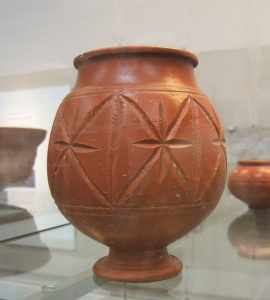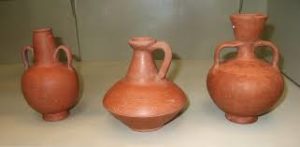Ancient Roman Ceramics: Most Roman potteries were adapted from the works of other civilizations. Much of the pottery created during this period was an imitation or adaption of Greek, Egyptian or Syrian pottery. Most Roman potteries were created through mainly mechanical processes and were not as artistic as other forms of.

Mainly the pottery created during this period were created in simple shapes that could be quickly and easily thrown. Pottery was produced in enormous quantities in ancient Rome, mostly for the purpose of utility. It is found all over the former Roman Empire and beyond.
Fine Ware
The ancient Roman domestic pottery can be broadly categorized into coarse wares and fine wares, the former being the everyday pottery jars, dishes and bowls that were used for cooking or the storage and transport of foods and other goods, and in some cases also as tableware, and which were often made and bought locally.
Fine wares were serving vessels or tableware used for more formal dining and were usually of more decorative and elegant appearance. Some of the most important of these were made at specialized pottery workshops, and were often traded over substantial distances, not only within, but also between, different provinces of the Roman Empire.
Roman Ceramics Vase Designs
There is no direct Roman equivalent to the artistically central vase-painting of Ancient Greece, and few objects of outstanding artistic interest have survived, but there is a large amount of fine tableware, and very many small figures, often incorporated into oil lamps or similar objects, and often with religious or erotic themes.

“Fine” rather than luxury pottery was the main strength of Roman pottery, unlike Roman glass, which the elite often used alongside gold or silver tableware, and which could be extremely extravagant and expensive.
The more expensive pottery tended to use relief decoration, usually molded, rather than colored, and often copied shapes and decoration from the more prestigious metalwork. Especially in the Eastern Empire, local traditions continued, hybridizing with Roman styles to varying extents. From the 3rd century, the quality of fine pottery steadily declined, partly because of economic and political disturbances, and because glassware was replacing pottery for drinking cups.
Fired clay or terracotta was also widely employed in the Roman period for the architectural purpose, as structural bricks and tiles, and occasionally as architectural decoration, and for the manufacture of small statuettes and lamps which were not normally classified under the heading ‘pottery’ by archaeologists.
Terra sigillata or red-gloss wares
The designation ‘fine wares’ was used by archaeologists for Roman pottery intended for serving food and drink at the table, as opposed to pots designed for cooking and food preparation, storage, transport and other purposes.
Although there were many types of fine pottery, for example, drinking vessels in very delicate and thin-walled wares, and pottery finished with vitreous lead glazes, the major class that comes first to mind was the Roman red-gloss ware of Italy and Gaul made, and widely traded, from the 1st century BC to the late 2nd century AD, and traditionally known as terra sigillata. These vessels had fine, fairly hard and well-fired buff to pink fabrics, with a naturally glossy surface slip ranging in color from light orange to quite a bright red.
Ancient Roman Ceramics Red Gloss Wares
ARS (African Red Slip) ware was the most widely distributed representative of the Sigillata tradition in the late-Roman period. (Occasional imports of ARS have been found as far afield as Britain in the 5th-6th centuries.

It was manufactured in the province of Africa Proconsularis and similar forms and fabrics were made for more local distribution in Egypt, which had its own very active and diverse Ancient Roman Ceramics traditions in the Roman period.
A wide range of bowls, dishes and flagons were made in ARS, but the technique of making entire relief-decorated vessels in molds was discontinued. Instead, applique motifs were frequently used where decoration in relief was required, separately made and applied to the vessel before drying and firing. Stamped motifs were also a favored form of decoration, and in the later centuries, Christian subjects and symbols often appear.
Other Fine Wares
Some of the shapes of Arretine plain wares were quite closely copied in the later 1st century BC and early 1st AD in a class of pottery made in north-east Gaul and known as Gallo-Belgic ware. Many of these plates and dishes in red-slipped and black-slipped fabrics bear potters’ stamps.
Other fine, thin-walled flagons, drinking beakers, bowls, and dishes were made locally in most regions of the Roman Empire, including frontier provinces such as Britain: for example, Romano-British ‘color-coated’ (slipped) wares made at Colchester and in the Nene Valley belong to that classification.
Several of the pots to the right of the group photograph in the lead section of this article are Nene Valley wares, including the large black beaker decorated with a lively hunting scene of hounds and hares in the barbotine technique. Many decorative techniques were used to beautify pottery tableware, including the use of colored slips, painting, and various textured surfaces.
Lead Glazed Pottery
Lead-glazed pottery was made in many regions of the Roman Empire, including Gaul, Italy and the eastern provinces. This type of vitreous glaze was most often used for small, decorative items of tableware, including mold-made cups with relief decoration, lamps, and zoomorphic containers. The glazes varied in color from amber to brown and many shades of green.
Tableware made of Egyptian faience, glazed in vivid blue, turquoise or green, continued to be manufactured in Egypt throughout the Roman period, and the shapes of some of these faience vessels in the 1st century BC and 1st AD were directly influenced by Arretine ware. Very elaborate, decorated polychrome faience vessels were also produced.
Egyptian faience, frit or ‘glazed composition’, as it is often termed by Egyptologists, has rather more in common technically with glass manufacture than with earthenware, since it is a non-clay Ancient Roman Ceramics material.




